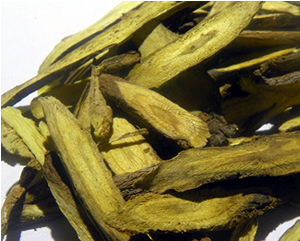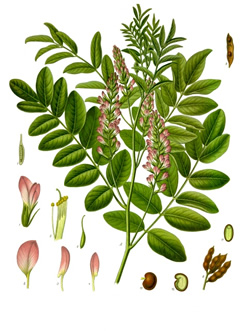Licorice Glycyrrhiza glabra

dried licorice root
- Common Names
- Licorice Root , Liquorice, Gan-cao
- Botanical Name
- Glycyrrhiza glabra
- Family
- FABACEAE
Medicinal Uses & Benefits of Licorice Root
![]() How to Use|
Side Effects |
Plant & Garden|
How to Use|
Side Effects |
Plant & Garden|
- Medicinal Uses: * Addiction
* Anxiety
* Bronchitis
* Candida/yeast
* Chinese
* Colds
* Congestion
* Fatigue
* IBS
* Psoriasis
* Sore Throat
* Stop Smoking
- Properties: * Antitussive * Breath * Depurative * Phytoestrogen
- Parts Used: root
- Constituents: glycyrrhizin, glycrrhetinic acid, resin licorcone, flavonoids
How to Use: Licorice
Many herbalists regard licorice as a natural alternative to hydrocortisone as it acts much like your body's own natural corticosteroids. Among its many medicinal benefits, licorice is considered an adrenal tonic, in particular, it increases production of the very chemicals that aid in the body's recovery from chronic anxiety and stress. White, Linda B. M.D. The herb's action as a fast-acting anti-inflammatory agent are attributed to the steroid-like actions of the triterpenes glycyrrhizin and glycyrrhetic acid (GA). Glycyrrhizin is a glycoside, a carbohydrate that yields a sugar and a non-sugar when broken. It tastes 50 times sweeter than sugar and is the major triterpenoid in licorice. Glycyrrhizin blocks prostaglandin production and inflammation with an antiarthritic action similar to hydrocortisone. ABC Although it supports the body's release of cortisol, it also inhibits some of the more detrimental side effects of that hormone's presence. It is used in many formulations to activate and increase the effects of other herbs. Licorice can also be used topically to tame autoimmune inflammatory reactions such as psoriasis. (Duke,James, Ph.D.)
Licorice is often used in bronchitis and cough remedies to soothe sore throats. It is expectorant, anti-inflammatory, and directly antiviral. A licorice derivative, deglycyrrhizinated licorice (DGL) is an excellent demulcent, and commonly used for throat, stomach, urinary, and intestinal irritations. Licorice has estrogenic and other steroidal properties and is used to normalize and regulate hormone production. (Gladstar, Rosemary) Altogether licorice root has such wide ranging and diverse medicanal properties it is no wonder it remains one the most widely used herbs in the traditions of many cultures both East and West.
In a recent survey of Western medical herbalists, licorice ranked as the 10th most important herb used in clinical practice. An astonishing number Chinese herbal formulas (over 5,000) use licorice to sweeten teas and to "harmonize" contrasting herbs. (Foster, Steven and Yue "Herbal Emissaries")
Preparation Methods & Dosage :Fresh or dried root chopped root tea, tincture
Licorice Remedies
In traditional Chinese medicine Gan-cao (licorice) is used in prescriptions for weak spleen and stomach energy, for coughs, sore throats, asthma, carbuncles, swelling with pain, sores with toxic matter, stomach ulcers, hepatitis, hysteria, and as a detoxicant for food or medicine poisoning, as well as to "mediate" or "harmonize" the poisonous character of toxic medicinal plants. 2
Licorice Side Effects: Not for long term use without medical advice, the key to using licorice is moderation. Licorice root can elevate blood pressure, lower potassium and cause water retention. Not for those who have hypertension, kidney problems, diabetes or heart problems.
Plant Description

Koehler's Medicinal-Plants 1887
- Plant Class: Perennial Woody
- Flowers/Fruit/Seeds:From the axils of the leaves spring racemes or spikes of papilionaceous small pale-blue, violet, yellowish-white or purplish flowers, followed by small pods somewhat resembling a partly-grown pea pod in form. In the type species glabra, the pods are smooth, hence the specific name; in others they are hairy or spiny.
- Parts used: Roots The underground system, as in so many Leguminosae, is double, the one part consisting of a vertical or tap root, often with several branches penetrating to a depth of 3 or 4 feet, the other of horizontal rhizomes, or stolons, thrown off from the root below the surface of the ground, which attain a length of many feet.
- Leaves:The plants are graceful, with light, spreading, pinnate foliage, presenting an almost feathery appearance from a distance. The leaflets (like those of the False Acacia) hang down during the night on each side of the midrib, though they do not meet beneath it.
- Flowering Season:
- Distribution:
Regional Traditions :Traditional Chinese Medicine *
History and Traditions & Folklore
Licorice is not really a flavor, rather the herb licorice has the sweet, somewhat musty flavor of anise. Licorice root is derived from the Mediterranean native species Glycyrrhiza glabra, the pea family. It was know to the old Greek writers, and mentioned by Theophrastus to be used for asthma, dry cough, and all diseases of the lungs. The plant was being cultivated in Europe and England by the end of the sixteenth century, is naturalized in North America. China has at least six species and Chinese herbals from every dynasty in Chinese history give the plant prominent recognition. As in the past, licorice is still one of the most commonly used traditional medicine herbs.- American Botanical Council . Licorice Monograph Snow, Joanne M. , HerbClip/ Protocol Journal of Botanical Medicine, (0000-00-00): Many studies confirm the anti-inflammatory effects of licorice root. These results are attributed to the steroid-like actions of glycyrrhizin and liquiritin. Glycyrrhetic acid (GA) has shown antiarthritic action similar to hydrocortisone. It also reduced inflammatory levels of serum glutamic pyruvic transaminase (S-GTP) (indicative of liver damage) and serum glutamic oxaloacetic transaminase (S-GOT) [representative of cellular damage].,













